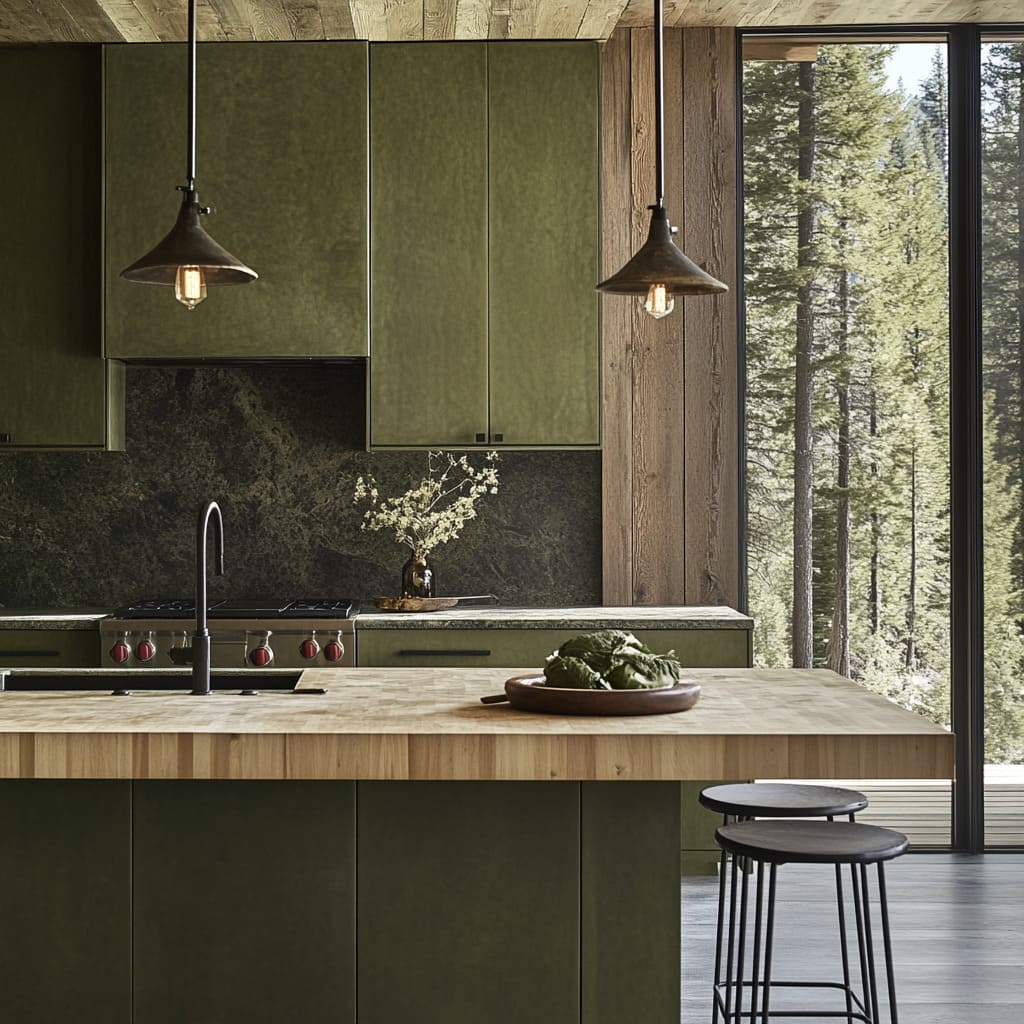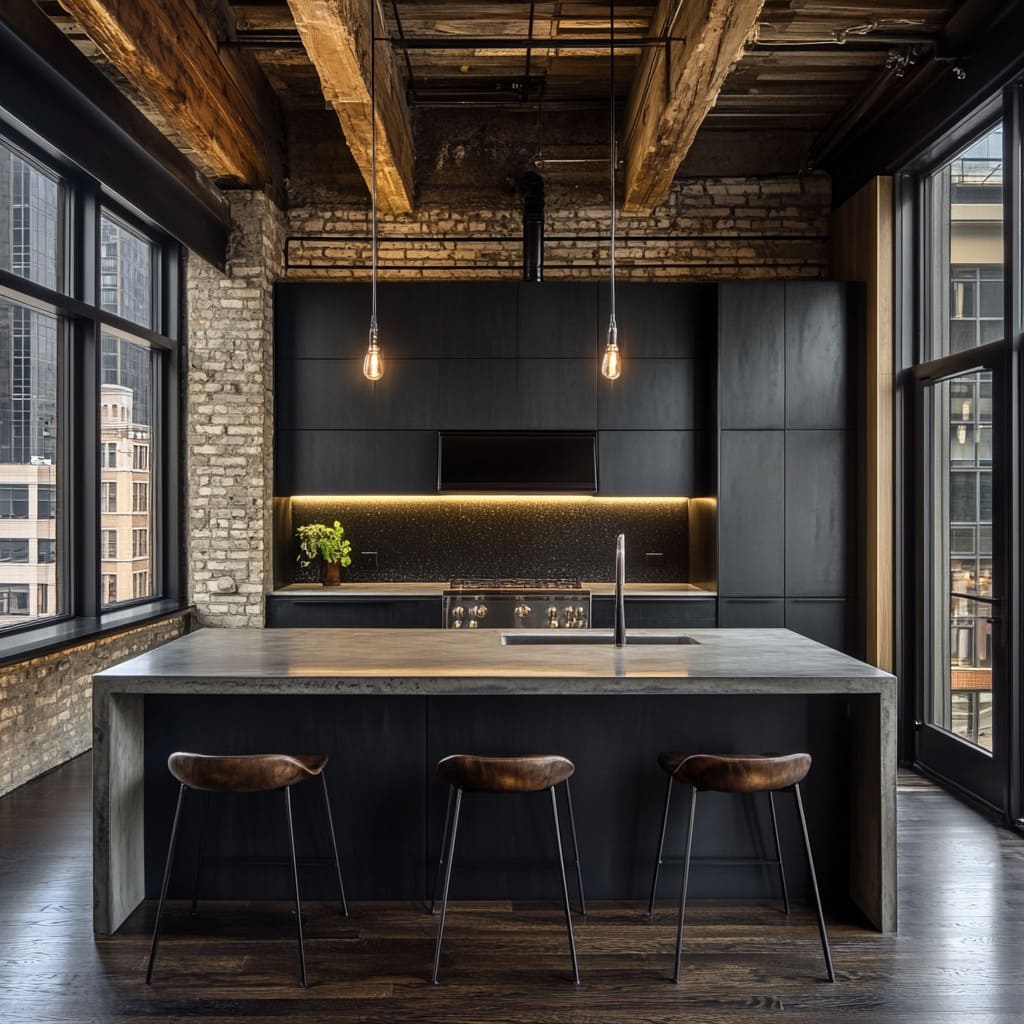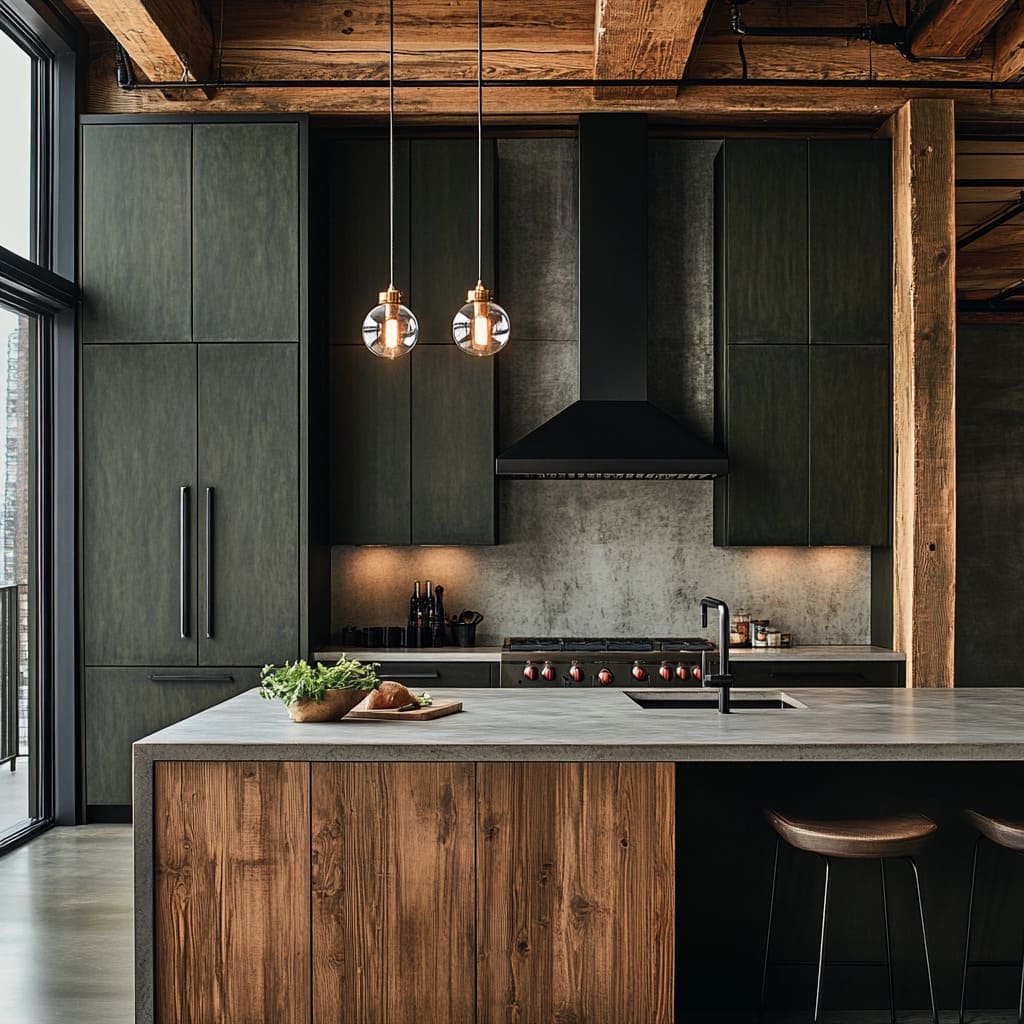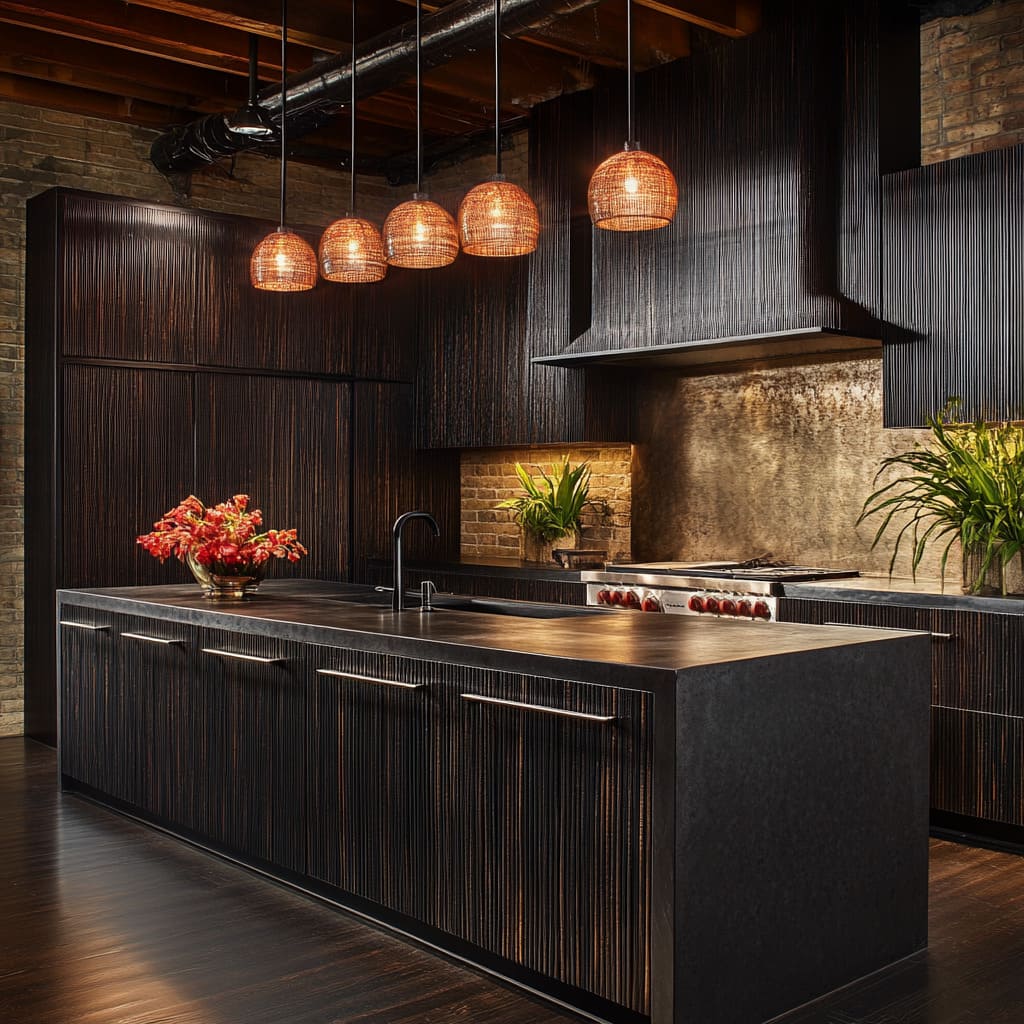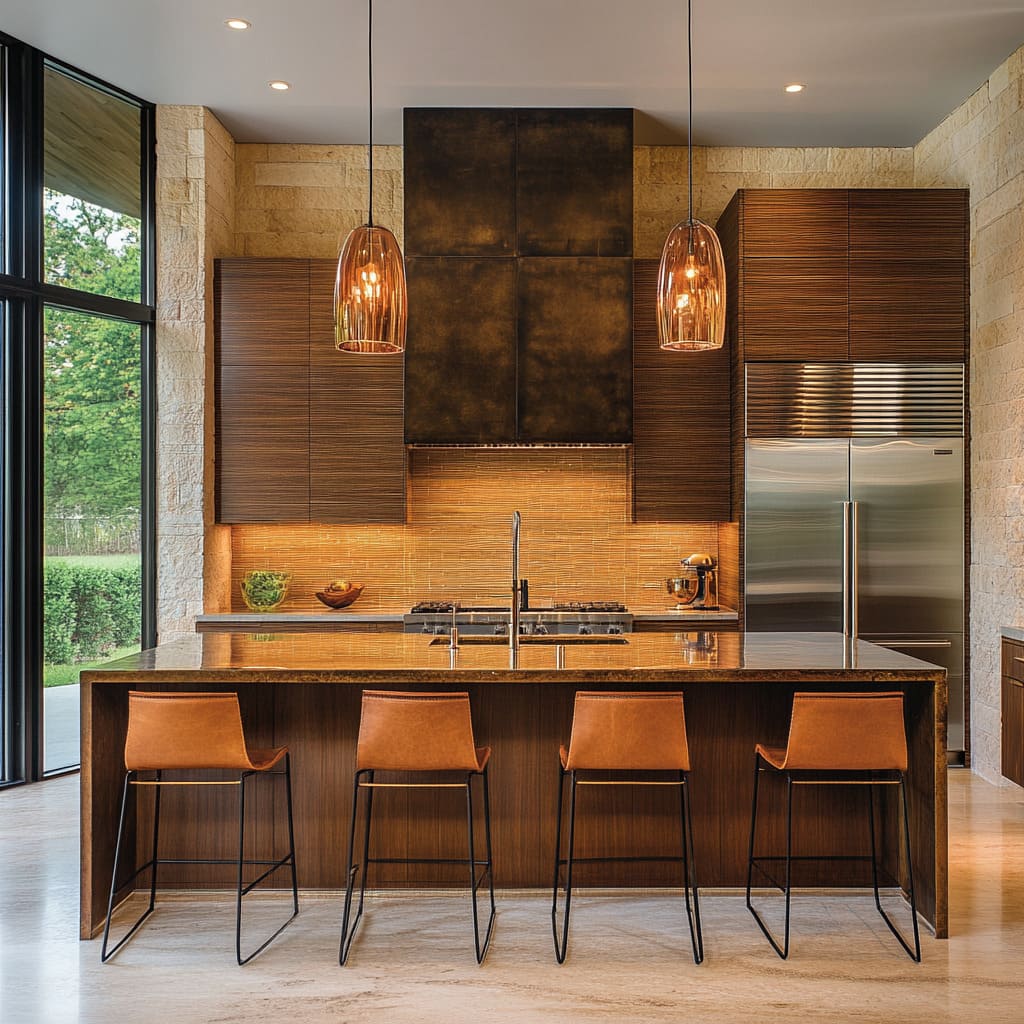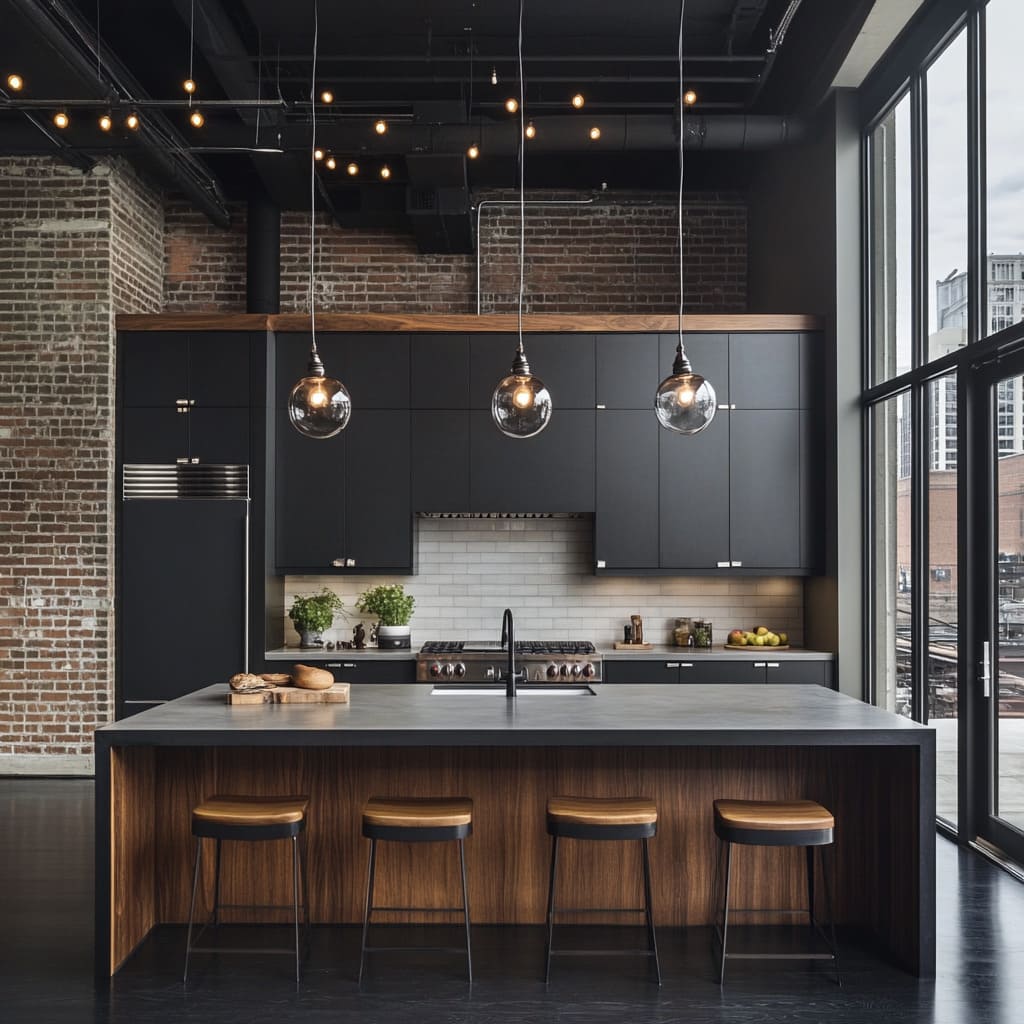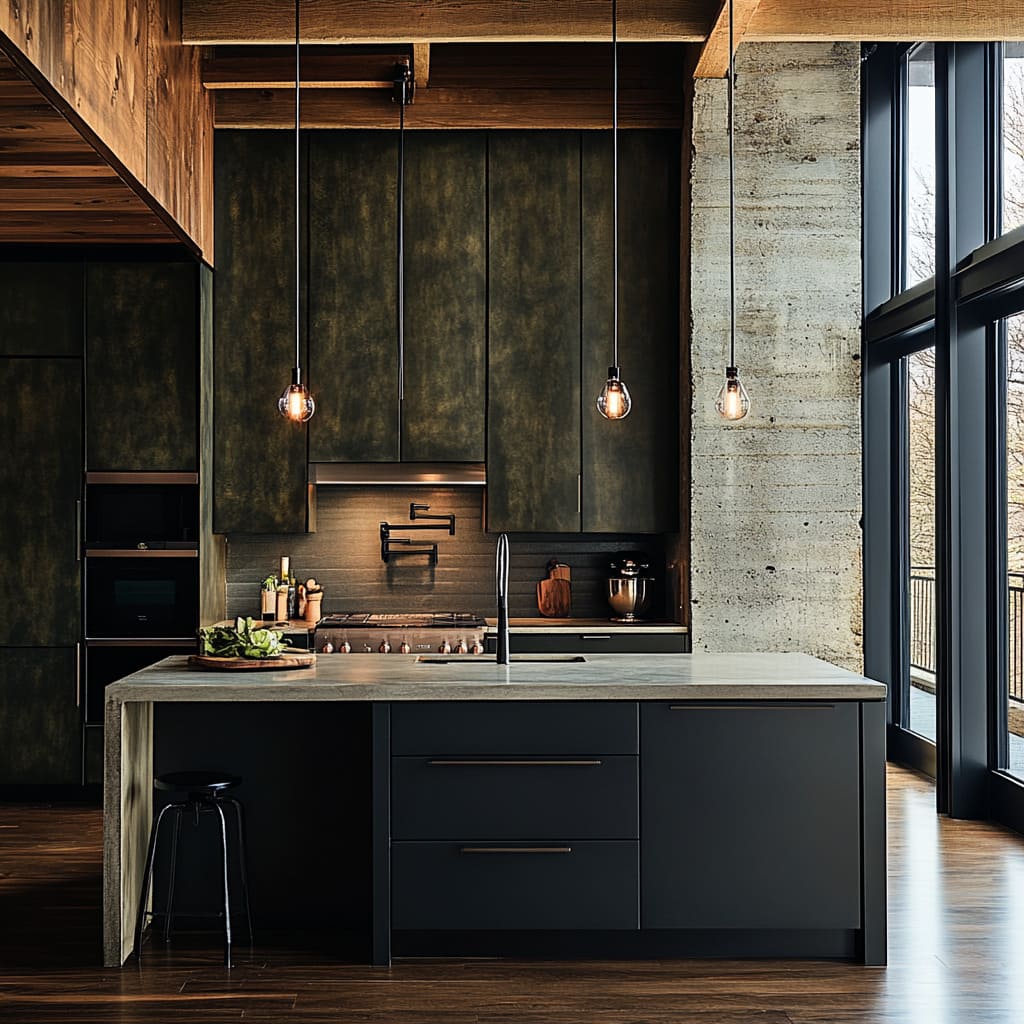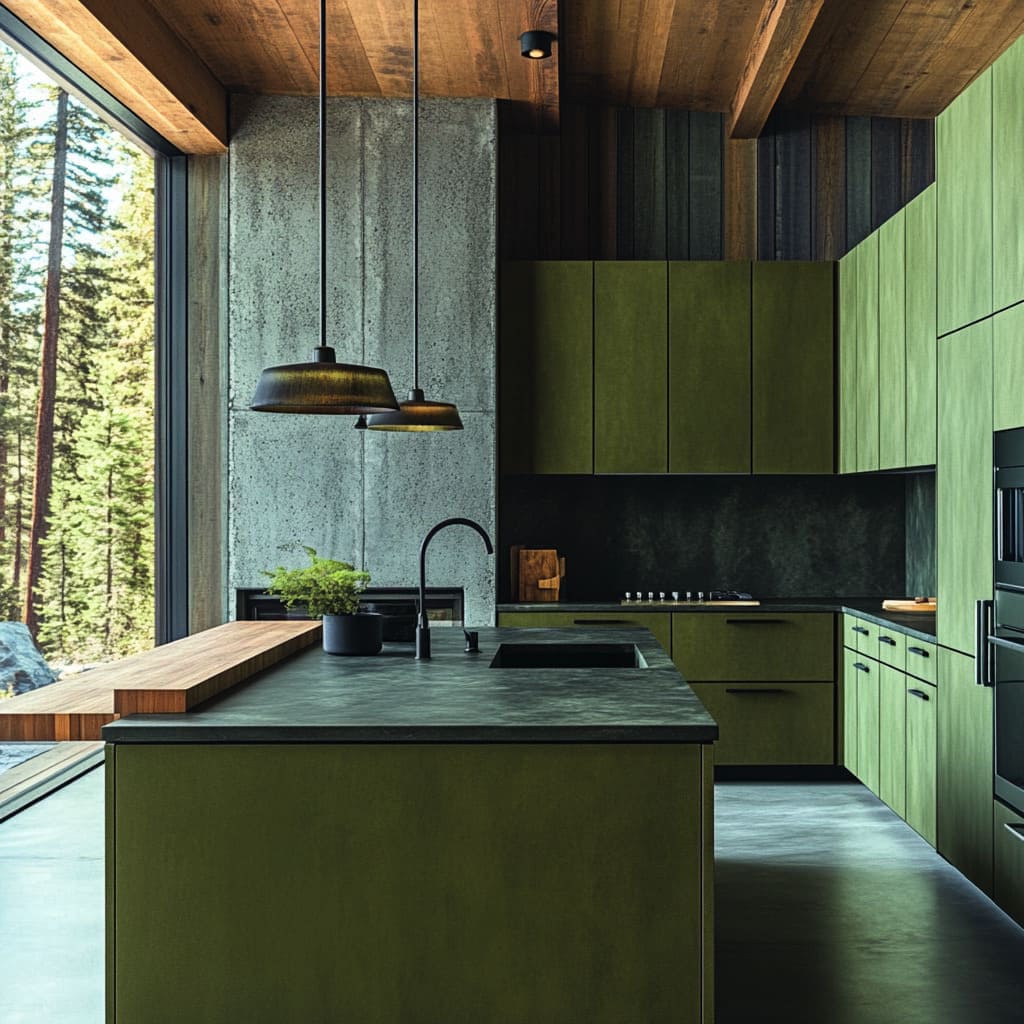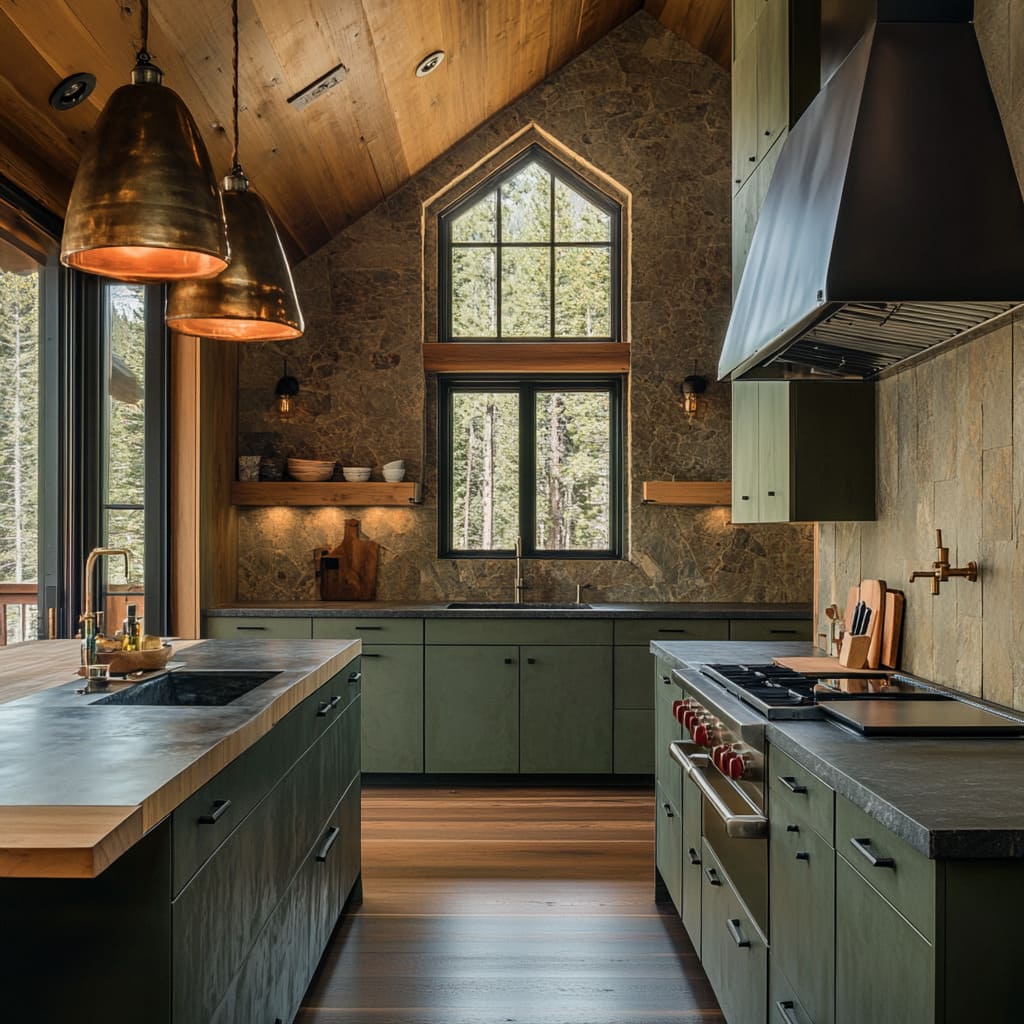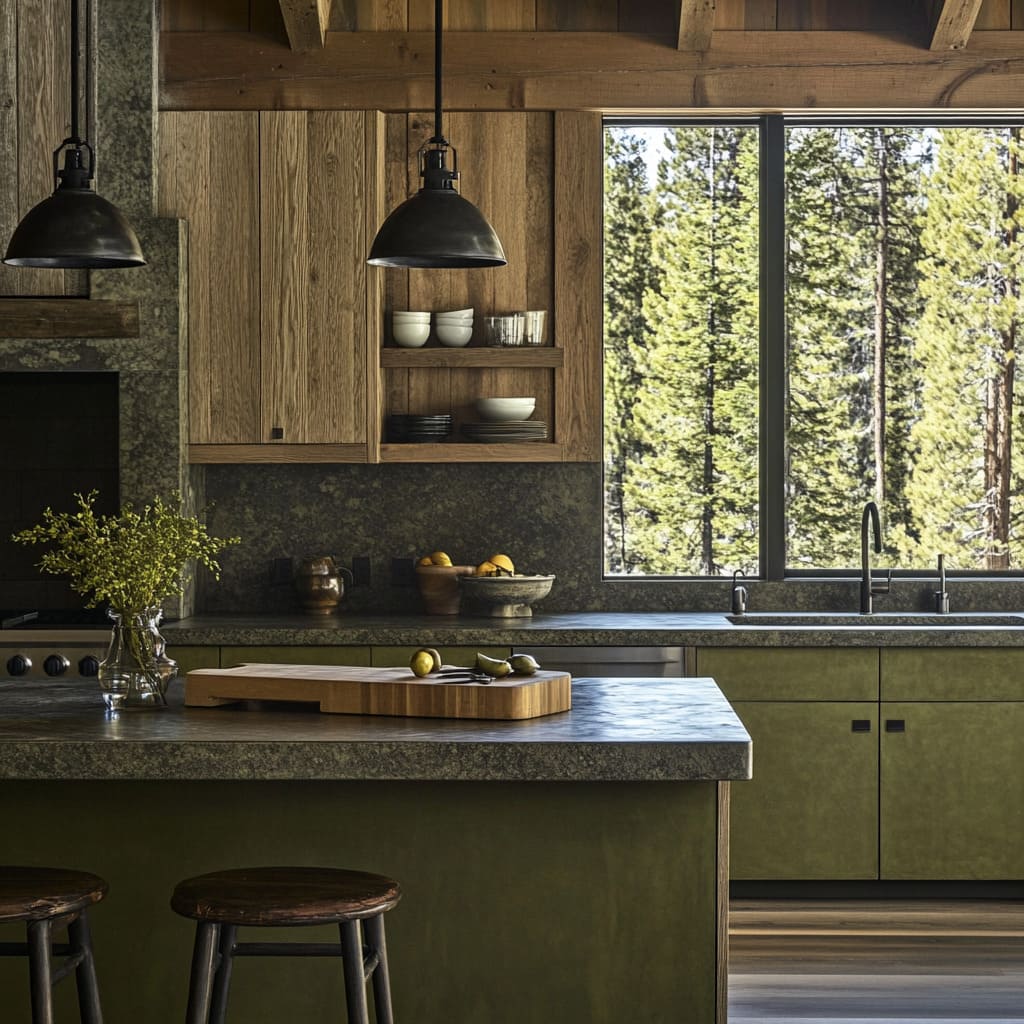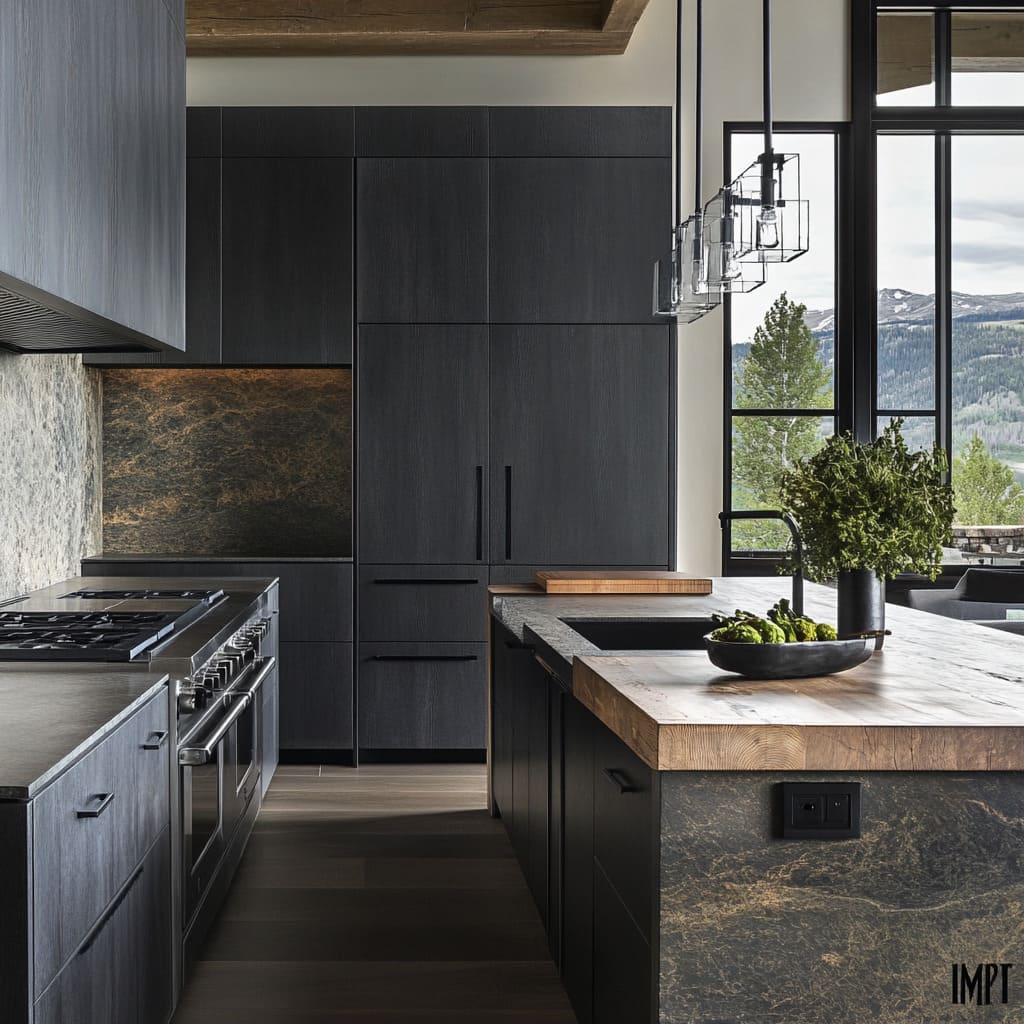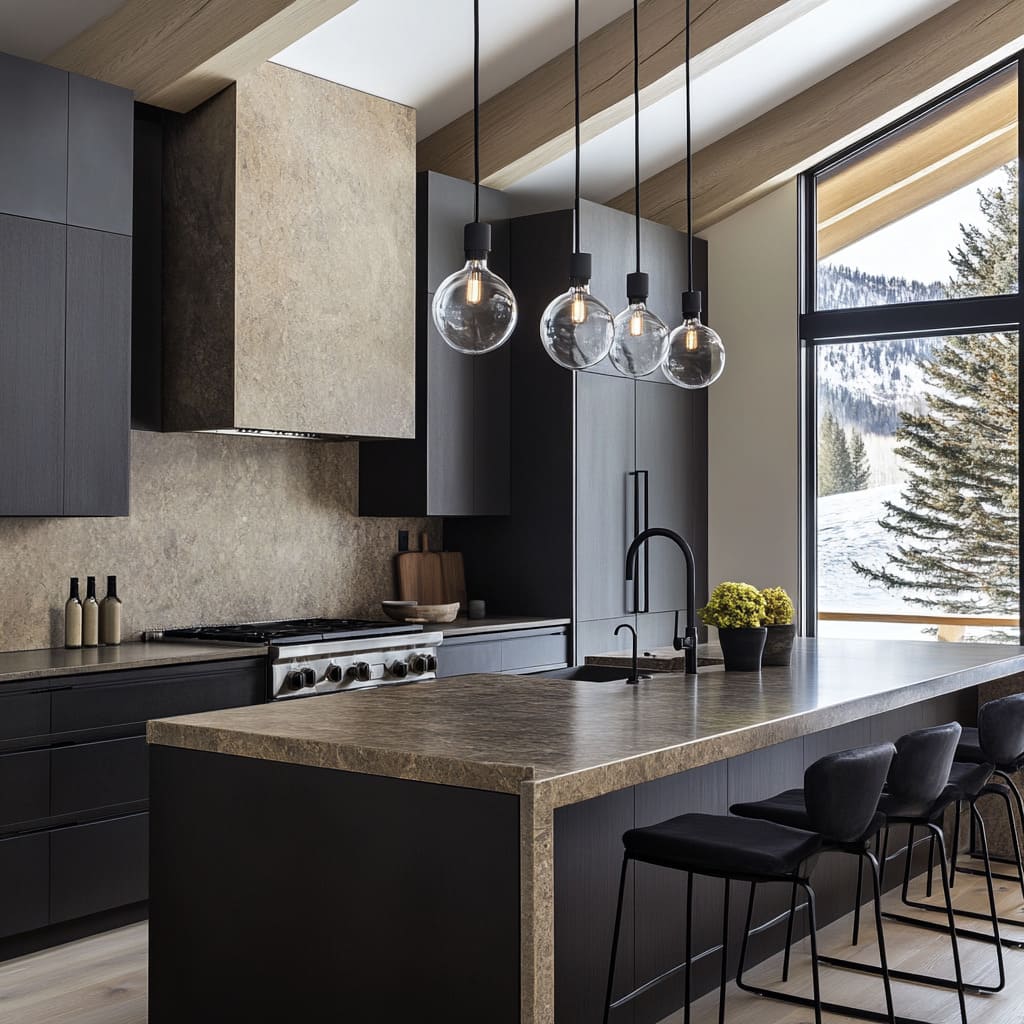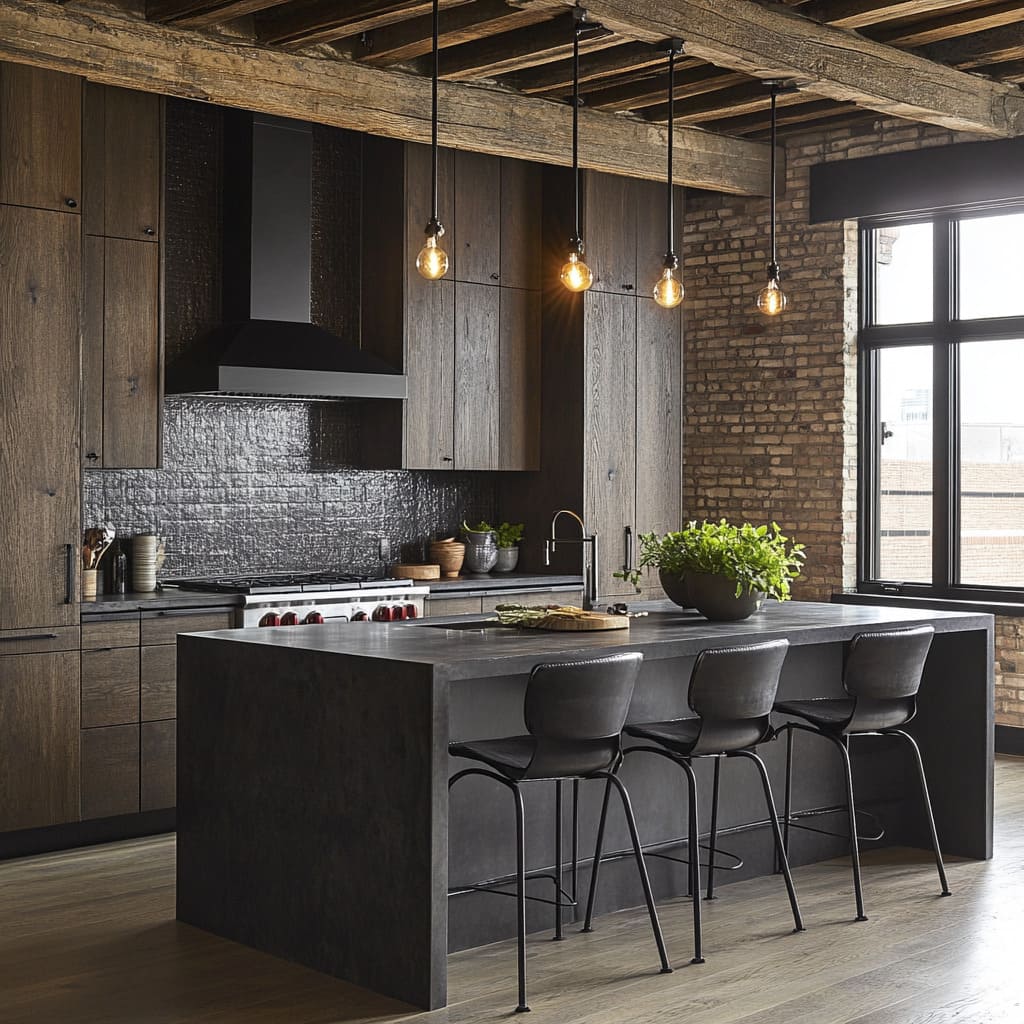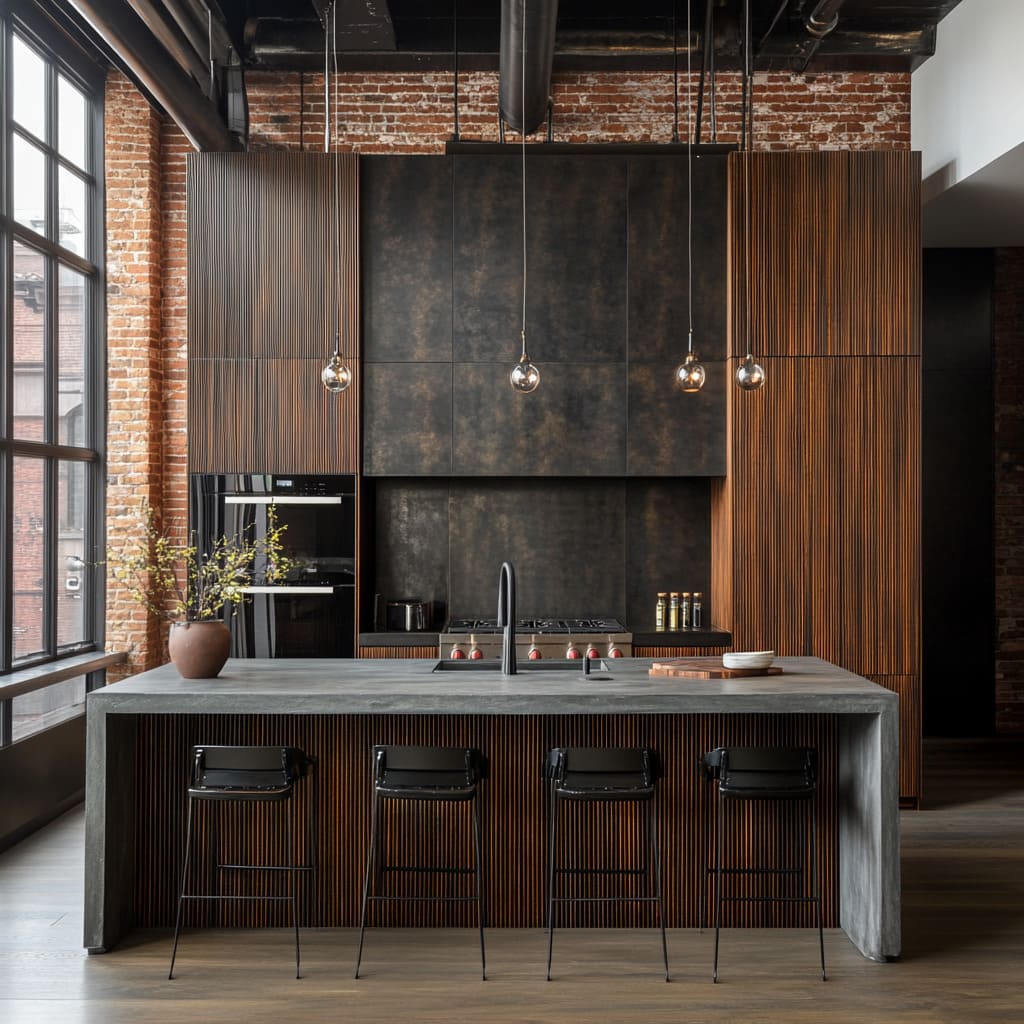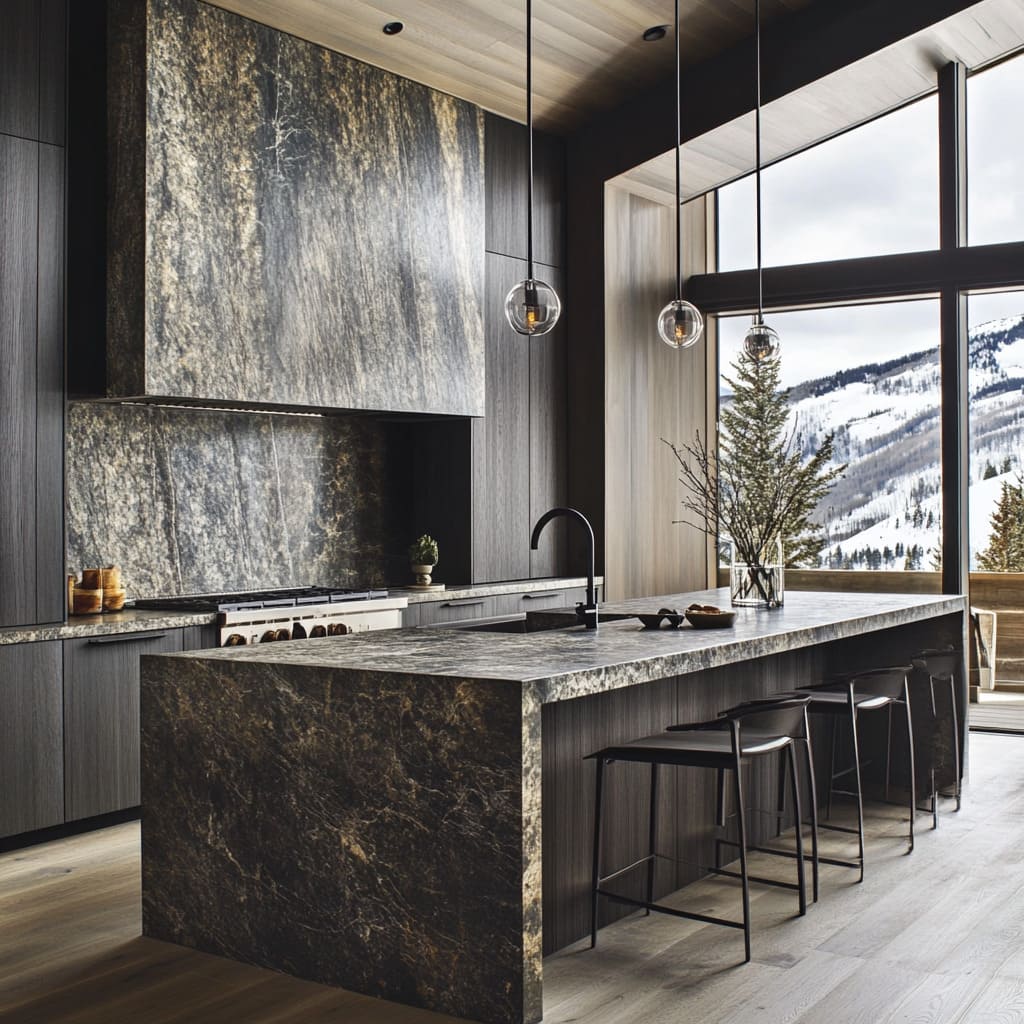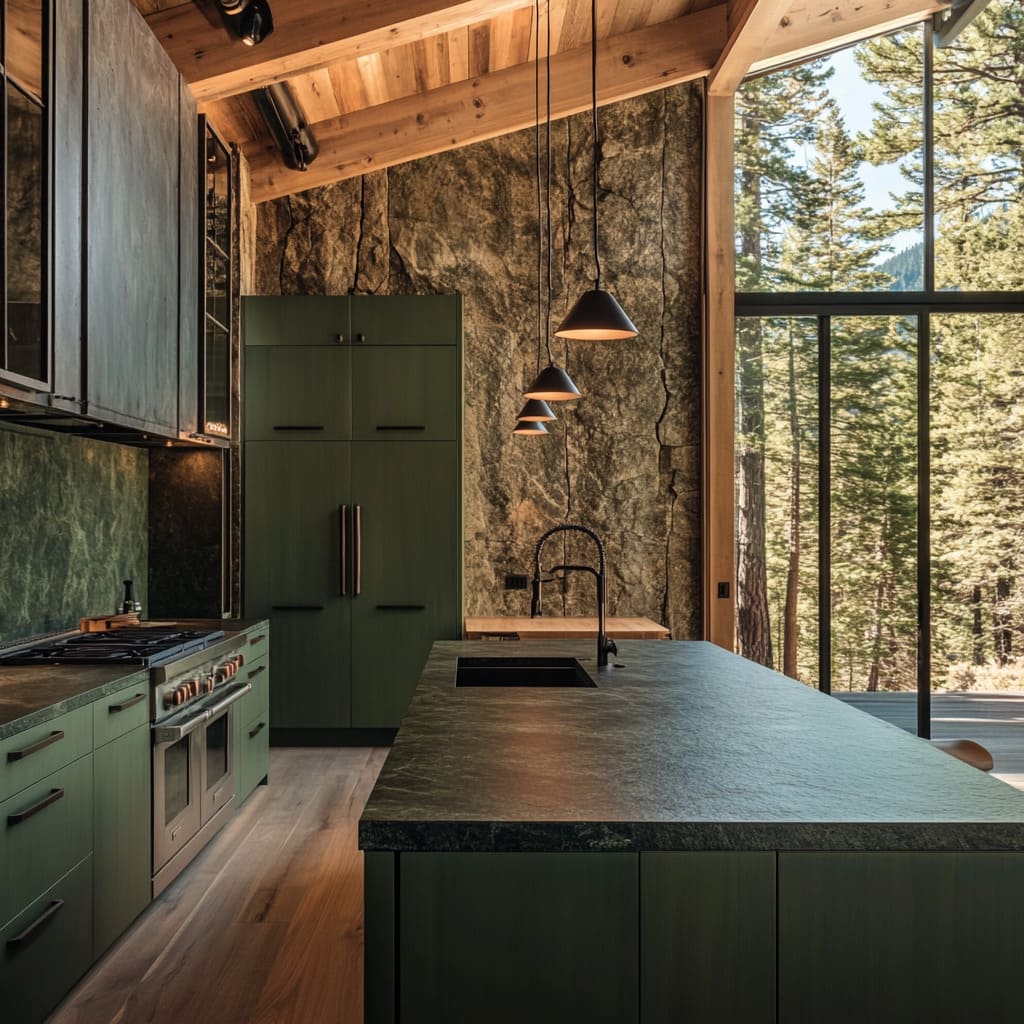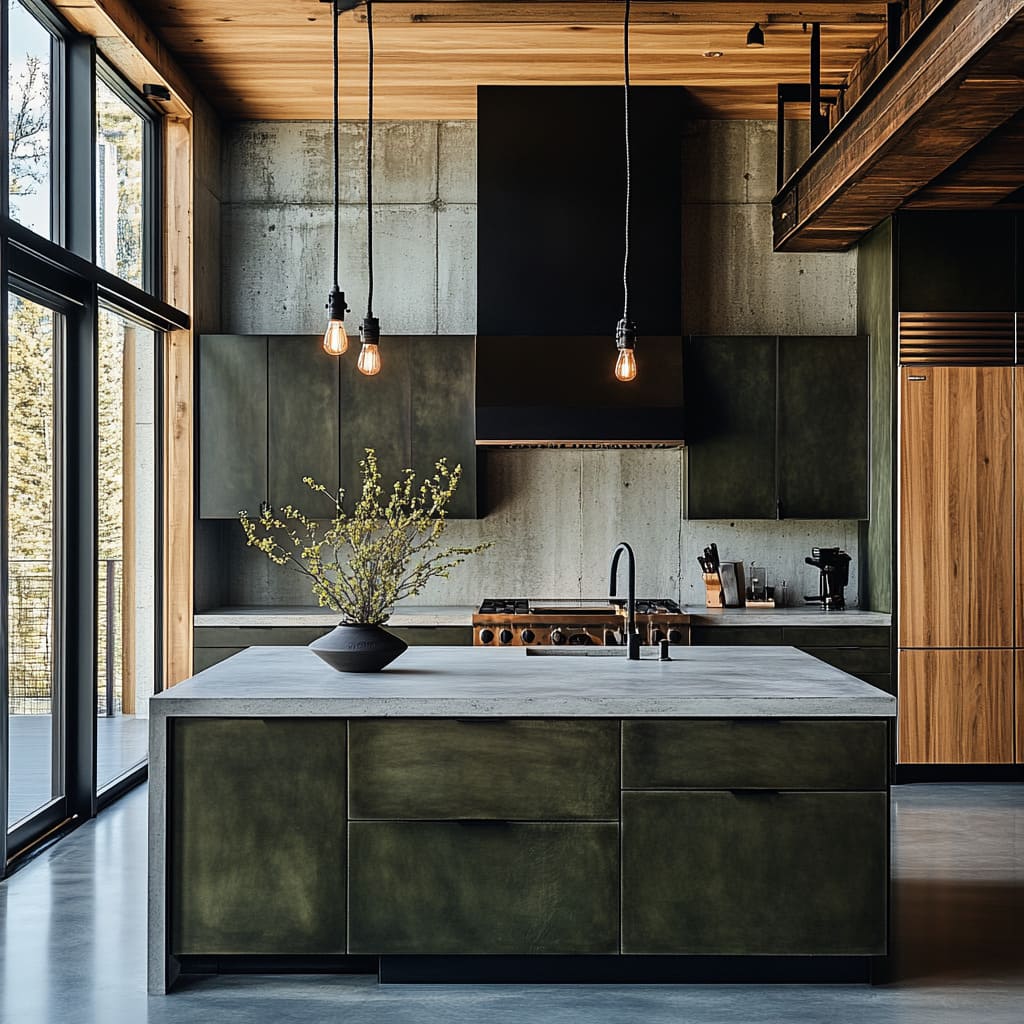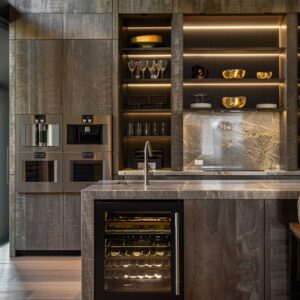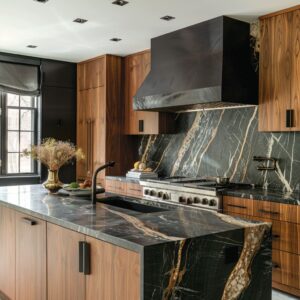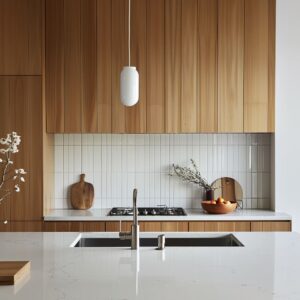Modern rustic kitchen design is a style that brings together the warmth of natural materials with the clean lines and functionality of contemporary design. At its core, this style is about creating a space that feels both welcoming and grounded, yet modern and stylish.
The blend of rustic and industrial elements takes this design to another level, adding a raw, edgy feel to the otherwise warm and inviting atmosphere of a rustic kitchen. Rustic kitchen design ideas often revolve around using natural materials like wood, stone, and metal.
These materials bring a sense of connection to the outdoors, which is especially appealing in spaces like kitchens, where warmth and durability are key. The addition of industrial elements such as exposed metal fixtures, concrete surfaces, and minimalist hardware enhances the rugged beauty of these natural materials, adding a modern touch to traditional rustic kitchens
The appeal of combining brutalist and rustic elements lies in the balance between the two styles. Brutalism, with its emphasis on raw materials and stark, functional design, contrasts beautifully with the warmth and texture of rustic materials.
This contrast creates a kitchen space that is both visually striking and deeply comfortable. It’s a style that speaks to those who appreciate the beauty in raw, unfinished materials, yet also want the warmth and comfort of a space that feels like home
Layout and Spatial Design
Open-Concept Layouts
One of the key features of modern rustic kitchen design is the open-concept layout. This layout is especially popular because it creates a seamless flow between the kitchen and adjacent living spaces, making the kitchen the heart of the home.
In a rustic kitchen, this open layout allows the natural beauty of the materials to be appreciated from different angles, creating a sense of cohesion throughout the space. Open-concept layouts are not just about aesthetics; they also enhance the functionality of the kitchen.
By removing walls and barriers, this design makes it easier to move between different areas of the kitchen and living spaces. This is particularly important in kitchens where the focus is on family gatherings and entertaining guests.
The open layout also makes the kitchen feel larger and more inviting, encouraging interaction and connection
An efficient workflow within the kitchen is essential, and this is where the triangle configuration comes into play. This classic layout places the stove, sink, and refrigerator at three points of a triangle, ensuring that all key elements are within easy reach.
This setup not only makes cooking more efficient but also helps to maintain a sense of order within the space. The triangle configuration is particularly effective in rustic kitchens, where functionality is just as important as aesthetics
Central Island as a Focal Point
The central island is a staple in modern rustic kitchen design, serving as both a practical workspace and a visual centerpiece. A well-designed island can transform the kitchen, providing additional countertop space, storage, and seating.
It’s a versatile element that enhances the overall functionality of the kitchen while also adding to its rustic charm. Rustic kitchen island ideas often feature natural materials such as wood and stone, which complement the surrounding cabinetry and countertops.
The island can be a place where rustic and industrial elements meet, with a wooden countertop paired with metal stools or an exposed concrete base. This mix of materials adds depth and interest to the design, making the island a focal point in the space
Functionality is key when it comes to the design of the island. Built-in sinks, ample storage, and seating are all elements that can be integrated into the island to enhance its utility.
For example, a rustic kitchen island might include deep drawers for pots and pans, open shelving for display items, and a seating area for casual dining. These features make the island a practical addition to the kitchen, serving multiple purposes while also contributing to the overall design.
Whether it’s used for meal prep, dining, or gathering with family and friends, the central island is an indispensable feature of modern country kitchen ideas. It brings together the rustic and industrial elements of the kitchen in a way that is both functional and aesthetically pleasing, making it the perfect centerpiece for a modern rustic kitchen
Wondering what kind of kitchen makeover your budget can achieve?
Discover what your budget can accomplish for your kitchen with our budget checker.
[budget_renovation_calculator]
Cabinetry and Color Palette Natural Wood Finishes
Rustic kitchen cabinets are a defining feature of this design style, bringing warmth and texture to the space. The use of natural, weathered wood in cabinetry adds a sense of authenticity and connection to nature, which is central to the rustic aesthetic.
These cabinets often feature simple, clean lines and minimal hardware, allowing the beauty of the wood to take center stage. The contrast between darker lower cabinets and lighter upper cabinets is a common technique in rustic kitchen design.
This contrast adds depth and interest to the space, creating a layered look that feels both balanced and dynamic. The darker cabinets ground the kitchen, providing a solid base, while the lighter upper cabinets open up the space, making it feel larger and more airy
Earthy and Industrial Color Schemes
Color plays a crucial role in setting the tone for a rustic kitchen. Earthy tones like mossy green, warm browns, and muted grays are often used to create a soothing, natural palette.
These colors evoke the feeling of being connected to the earth, making the kitchen feel cozy and inviting. When combined with industrial colors such as matte blacks and steely grays, the palette takes on a modern edge, adding sophistication and a touch of urban style to the rustic setting.
These color choices not only enhance the aesthetic appeal of the kitchen but also strengthen the connection between the indoor space and the natural world outside. The palette works in harmony with natural materials like wood, stone, and metal, ensuring that the kitchen feels cohesive and well-integrated
Minimalist Design Approach
In modern rustic kitchen design, simplicity is key. This is where the minimalist design approach comes in, with flat-panel doors and handle-free cabinets creating a clean, uncluttered look.
This simplicity allows the natural materials and textures to stand out, ensuring that the kitchen feels warm and welcoming without being overwhelming. The balance between modern minimalism and rustic warmth is what makes this style so appealing.
It combines the best of both worlds: the clean lines and functionality of modern design with the natural beauty and comfort of rustic elements. This minimalist approach ensures that the kitchen remains practical and easy to maintain, while still offering a space that feels rich in texture and character
Backsplash and Wall Treatments
Textured Stone and Metal Backsplashes
In the realm of modern rustic kitchen designs, the backsplash is not just a functional element but a key design feature that adds depth and character to the space. A dark, textured stone backsplash is an excellent way to introduce a sense of rugged elegance into the kitchen.
These backsplashes, often made from materials like slate, soapstone, or honed granite, provide a rich, tactile quality that draws the eye and anchors the overall design. The subtle variations in color and texture of the stone create a natural, organic feel that complements the earthy tones typically found in modern rustic kitchen ideas
Incorporating distressed metal into the backsplash adds an industrial edge that enhances the modern aspect of the design. Metal backsplashes, especially those with a weathered or patinated finish, introduce a bold, industrial element that contrasts beautifully with the warmth of natural wood and stone.
This combination of materials creates a dynamic interplay between rustic charm and industrial toughness, adding layers of interest and complexity to the kitchen. These rustic kitchen backsplash ideas are about more than just aesthetics; they are also highly functional.
The durability of stone and metal makes them ideal for areas that are prone to splashes and spills, ensuring that the kitchen remains practical while also being visually appealing
Natural and Rustic Wall Cladding
The walls in a modern rustic kitchen play a significant role in defining the space’s overall vibe. Natural and rustic wall cladding options like wood or concrete are perfect for enhancing the kitchen’s rustic, industrial aesthetic.
Wood cladding, particularly when left in its natural state or lightly treated, adds warmth and texture, making the kitchen feel inviting and connected to the natural world. This approach works especially well when paired with modern rustic kitchen cabinets, as the combination creates a seamless flow between the different elements of the kitchen.
Concrete finishes, on the other hand, offer a more industrial feel, with their raw, unfinished look providing a stark contrast to the warmth of wood. The cool, matte surface of concrete can serve as an excellent backdrop for more textural elements in the kitchen, such as wooden beams or metal fixtures.
When used strategically, these materials can transform a simple kitchen wall into a feature that enhances the overall design narrative of the space. Full-height backsplashes are another technique used to create a cohesive and uninterrupted visual flow in the kitchen.
Extending the backsplash material from the countertop to the ceiling not only protects the walls but also creates a bold statement that emphasizes the height and scale of the kitchen. This approach is particularly effective in modern rustic kitchen designs, where the emphasis is on blending functional elements with striking design choices
Range and Hood Design
Professional-Grade Appliances
When it comes to modern rustic kitchen ideas, the appliances you choose can significantly influence both the functionality and aesthetic of the space. Integrating professional-grade, industrial-style appliances into the kitchen ensures that it meets the demands of serious cooking while also adding a touch of modern sophistication.
These appliances, often characterized by their stainless steel finish and robust construction, blend seamlessly with the rustic elements of the kitchen. The benefit of such appliances goes beyond their visual appeal.
Their high-performance features make cooking more efficient and enjoyable, aligning with the practical nature of rustic kitchens. The sturdy, industrial look of these appliances contrasts with the softer, more organic materials used elsewhere in the kitchen, creating a balanced and well-rounded design.
Custom Range Hoods
A custom-designed range hood is often the centerpiece of a modern rustic kitchen. Whether crafted from metal, stone, or a combination of both, the range hood can serve as a central focal point that ties the entire kitchen design together.
Metal range hoods, with their sleek lines and industrial feel, add a modern edge to the kitchen, while stone hoods offer a more traditional rustic aesthetic. The materials used for the range hood should complement the overall design scheme.
For example, a metal hood with a patina finish can introduce a sense of history and depth to the space, while a stone hood can echo the textures and tones of the backsplash and countertops. The design of the hood should not only be aesthetically pleasing but also highly functional, ensuring proper ventilation and enhancing the kitchen’s overall performance
Estimate the budget required for your kitchen remodel using our tool
Lighting Design
Pendant Lighting
Lighting is crucial in any kitchen, but it takes on added importance in a modern rustic kitchen, where it helps to highlight the natural materials and create a warm, inviting atmosphere. Pendant lighting over the kitchen island is particularly effective, providing focused task lighting while also serving as a decorative element that enhances the room’s overall aesthetic.
The style of pendant lighting can vary widely, from industrial matte black fixtures that add a touch of urban sophistication to woven rattan shades that bring in a more rustic, handcrafted feel. The key is to choose fixtures that complement the other elements in the kitchen, whether through matching materials, colors, or styles
Layered Lighting for Ambiance Creating a welcoming and balanced environment in the kitchen requires a layered approach to lighting. This involves combining pendant lights with recessed ceiling lights and under-cabinet lighting to ensure that the space is well-lit and functional at all times of the day.
Recessed lights provide general illumination, ensuring that the kitchen is bright and airy, while under-cabinet lights highlight the countertops and backsplash, bringing out the textures and colors of the materials. The role of lighting in a modern rustic kitchen goes beyond mere functionality.
It also plays a critical part in enhancing the natural materials and creating a cozy, inviting atmosphere that makes the kitchen feel like the heart of the home. By carefully selecting and placing different types of lighting, you can ensure that your kitchen is not only practical but also a warm and welcoming space that reflects your style and personality
Flooring and Ceiling Treatments
Natural Wood Flooring
One of the key elements that defines the character of a modern rustic kitchen is the choice of flooring. Wide-plank wood flooring is a popular option, adding both warmth and texture to the space.
The natural grain and tones of wood provide a foundation that is rich and inviting, setting the tone for the entire kitchen. Whether the wood is a light oak, a deep walnut, or a reclaimed timber, it brings an organic quality that complements the other materials used in the kitchen
The choice of wood flooring in industrial rustic kitchen ideas often involves a balance between rustic charm and modern sophistication. The wide planks add a sense of scale and continuity to the space, while the natural imperfections in the wood — knots, grain patterns, and color variations — contribute to the kitchen’s authenticity.
This type of flooring works particularly well when paired with contrasting elements, such as metal fixtures or stone countertops, creating a harmonious balance that ties the whole design together. The tone of the wood flooring should be carefully considered in relation to the other elements in the kitchen.
For instance, darker flooring can ground a space and provide a dramatic contrast to lighter cabinets or countertops. On the other hand, lighter wood tones can make a kitchen feel more open and airy, especially in spaces with ample natural light.
The goal is to achieve a balance where the flooring enhances the overall aesthetic without overwhelming the other design elements
Exposed Beams and Ceiling Designs
Incorporating exposed wooden beams into the ceiling design is a hallmark of rustic modern farmhouse kitchen ideas. These beams add structural interest and a sense of history to the kitchen, evoking the traditional craftsmanship of older homes while blending seamlessly with modern design elements.
Exposed beams not only draw the eye upward, emphasizing the height of the room, but they also contribute to the overall warmth and texture of the space. The material and finish of the beams are crucial in defining the kitchen’s style.
Natural, unfinished wood beams give a more rustic feel, while beams with a darker stain can add a touch of sophistication and contrast. For a more industrial look, beams might be paired with metal brackets or hardware, which tie in with other industrial elements in the kitchen.
Beyond beams, the ceiling itself can be treated in various ways to complement the rustic and industrial elements of the kitchen. Options such as wood cladding, tin ceiling tiles, or even concrete finishes can add texture and interest to the ceiling, making it an integral part of the kitchen’s design.
The ceiling treatment should be consistent with the overall design scheme, enhancing the rustic, industrial vibe without detracting from the functionality of the space
Windows and Natural Light
Maximizing Natural Light
Maximizing natural light is essential in any kitchen, but it takes on particular importance in rustic country kitchen ideas. Large windows that let in plenty of sunlight help to create a bright, welcoming environment and highlight the natural materials used throughout the space.
Natural light brings out the warmth of wood, the texture of stone, and the subtle patina of metal, making each element feel more alive and connected to the surrounding landscape
In kitchens where the view is a key feature, large windows or even floor-to-ceiling glass can blur the lines between indoor and outdoor living. This approach not only enhances the rustic ambiance but also creates a seamless transition from the kitchen to the natural beauty outside.
The interaction of natural light with the materials in the kitchen can transform the space throughout the day, casting different shades and highlights that bring out the unique qualities of each material
Framing Views and Integrating Indoor-Outdoor Living
Strategic placement of windows is key to framing scenic views and making the most of the kitchen’s natural surroundings. In a kitchen with a view of mountains, forests, or gardens, positioning windows to capture these vistas can make the kitchen feel like an extension of the outdoors.
This connection to nature is a fundamental aspect of rustic modern farmhouse kitchen ideas, where the design is as much about what’s outside as it is about what’s inside. Incorporating sliding doors or large windows that open onto a deck or patio can further enhance this indoor-outdoor connection.
This design choice is particularly effective in climates where outdoor living is a part of everyday life. The flow between the kitchen and outdoor spaces makes entertaining and dining more flexible and enjoyable, aligning perfectly with the casual, welcoming nature of rustic and industrial farmhouse kitchen ideas
Integration with Surroundings
Designing for the Setting
When designing a kitchen in a setting like Lake Tahoe or another rustic, mountainous region, it’s important to tailor the design to complement and enhance the natural surroundings. This involves selecting materials, color palettes, and layouts that feel like an extension of the landscape.
Natural stone, weathered wood, and earthy tones can all be used to create a kitchen that feels harmonious with its environment, blending seamlessly with the scenery outside
The materials chosen for the kitchen should reflect the textures and colors found in nature. For instance, stone countertops and backsplashes might mimic the look of nearby rock formations, while wood cabinetry and flooring could be selected to match the tones of the surrounding forest.
This approach not only grounds the kitchen in its setting but also creates a cohesive design that feels intentional and connected to its surroundings
In rustic modern farmhouse kitchen ideas, the goal is to create a space that is both functional and aesthetically pleasing, while also being mindful of the environment it inhabits. By thoughtfully selecting materials and design elements that resonate with the natural landscape, you can create a kitchen that feels like a true part of its setting — a space where the beauty of the outdoors is reflected and celebrated within the home
Conclusion
In conclusion, the beauty and functionality of modern rustic kitchens with industrial elements lie in the careful balance of raw materials, thoughtful design, and the seamless integration of the kitchen with its natural surroundings. Whether it’s through the use of natural wood flooring, the strategic placement of windows, or the choice of materials that complement the landscape, these kitchens offer a unique blend of style and substance that is both timeless and contemporary

